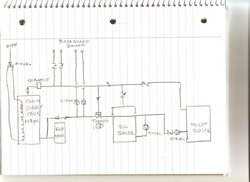Thanks for the replies everyone.
Was trying to lump all of the replies into a single thread, but dont see the multi-quote option. Maybe thats other forum software?
Anyway, BadLP, thanks for the insight. Im familiar with Watts, and they make good stuff. But I see they top out at 1 1-4", and the piping I have leaving my boiler is 1 1/2", so I would rather just stay line size if I can.
Velvet, I know its only $37, but thats money to put towards other projects, especially since Im hoping this thing only does its job for the first few days/weeks I fire the system up.
Noah, it has been a while! When its not time to heat the house there are always other things to do, plus I now have a little guy running around keeping me busy, so my forum interactions are pretty curtailed.
Leon, thanks for the insightful questions here. My near-boiler piping isnt ideal, and that was a cost-based decision to tie my new wood boiler system into the existing oil boiler. For purposes of this discussion, Im only dealing with my oil loop, which has two zones, pumps on the return side of the boiler, pumping towards the expansion tank. So yes, not correct/ideal. But it was piped by an old timer that used the old rules of thumb, and it was to replace what had been an old monster of a boiler. Rule of thumb was to install pumps on the return side so they would see lower temps and not bake the seals. It also had the old-style expansion tank in the rafters that you would drain down or use an airtrol fitting. That tank is currently valved off, and there is a diaphragm-style tank piped off of a tapping on the boiler itself.
=======================================================================================================================================================================================================================================================================================================================
Hello Clarkbug,
you can still use the steel tank with your wood boiler and oil boiler both as long as you eliminate all the autovents.
The autovents stole all the air out of the steel tank causing you to add water back to the system.
You can leave the bladder tank in place and still use the steel expansion tank as long as the autovents are removed.
The new pumps can be installed above the steam chests now to push the water away from the boiler(pumping away)
as they have high temp seals and do not fail from heat and this is best for ridding your system of water.
If you have a boiler tapping on the steam chest that is unused you can add a 2 foot pipe nipple and a boiler drain to aid in removing all your air and then you can open the valve to the steel expansion tank and then open the air vent in the airtrol fitting and when the water starts squirting out your tank has the right amount of air and water- 1/3 air and 2/3 water and then you have no issues.
I would bet you had problems the minute you started to heat with the new boiler and the automatic air vents!! eliminate these air vents, purge the air in the system fill the steel tank andd then drain the excess air out of the steel tank and you will no longer have issues.
Is your woof boiler pressurised?? If not you may need a heat exchanger so you can eliminate the automatic air vents.
========================================================================================================
I had issues last year with air in the system, and I have finally found the problem, which was the auto-vents installed on my tanks inside an insulated enclosure. They were weeping around the top seal, and I was having to makeup, so adding more air into the system that the spirovent on my wood loop couldnt always get to. So Im in the process of re-piping those vents, trying to decide on adding a manual coin vent on piping outside the enclosure, or just putting a pipe plug in and calling it a day.
Since I have some other piping changes to make, I was thinking best to add an air eliminator because its good practice to have one after the boiler.


